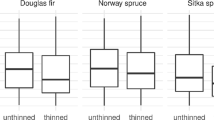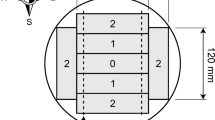Abstract
Grades derived from visual assessments of sawn timber are determined by the worst part of each piece. Since grade varies longitudinally in timber, grade yield will decrease if the average length of timber increases. The variation in grade is caused by longitudinal variation in knot properties and other features as they appear on the sawn surface taken into account during grading. The objective of this study is to describe and analyze this variation in Picea abies.
The study consisting of 768 boards for which all features that could lead to downgrading were recorded noting position, type and size. Based on this information, all boards were graded according to appearance by Nordic Timber, and strength by INSTA 142. Logistic regression models of grade as a function of position in the stem were developed, and the dependence between responses was taken into consideration by using General Estimating Equations (GEE). The models showed a decreasing trend in grade from the butt end toward the top end of the trees, and the effect was more pronounced in strength grading than in appearance grading. Models with binomial response and different correlation structures were tested, and it was shown that both independent and autoregressive correlation structures could be used. This suggests that a multinomial ordinal logistic regression with a GEE-approach with an independent correlation structure is appropriate for modeling grade in this study.
Zusammenfassung
Bei der visuellen Sortierung wird Schnittholz anhand des größten Fehlers im jeweiligen Stück in eine Sortierklasse eingestuft. Da die Sortierklasse innerhalb eines Holzes in Längsrichtung variiert, nimmt die Ausbeute in den Sortierklassen mit zunehmender Holzlänge ab. Die Veränderungen der Sortierklasse beruhen auf den Veränderungen der Asteigenschaften und anderen sortierentscheidenden, visuell erkennbaren Merkmalen in Längsrichtung. Ziel dieser Studie ist es, diese Veränderungen in Picea abies zu beschreiben und zu untersuchen.
Untersucht wurden 768 Schnitthölzer, 38–50 mm dick und 100–225 mm breit, von denen alle sortierrelevanten Merkmale bezüglich Lage, Art und Größe bestimmt wurden. Alle Schnitthölzer wurden nach dem Aussehen gemäß Nordic Timber sowie nach der Festigkeit gemäß INSTA 142 sortiert. Spezielle Regressionsmodelle wurden unter Berücksichtigung der Autokorrelation der Daten entwickelt. Die Modelle zeigten einen Trend zu niedrigeren Sortierklassen vom Fällschnitt bis zum Zopf des Stammes, und dieser Effekt war bei der Festigkeitssortierung stärker ausgeprägt als bei der Sortierung nach dem Aussehen. Verschiedene Modelle mit unterschiedlichen Korrelationsansätzen wurden untersucht und es wurde gezeigt, dass sowohl Modelle mit einfacher Korrelation als auch mit Autokorrelation verwendbar sind. Daraus folgt, dass der hier verwendete multinominale Regressionsansatz ohne Berücksichtigung der Autokorrelation zur Modellierung des Verlaufs der Sortierklassen geeignet ist.
Similar content being viewed by others
References
Abetz PV, Unfried P (1983) Branch diameters of future crop trees in a stand density experiment with Norway spruce in the forestry district Riedlingen/Donau. Allg. Forst- Jagdztg 154:189–197
Agresti A (2002) Categorical data analysis. Wiley-Interscience, New York
Anonymous (1994) Nordic Timber. Grading rules for pine and spruce sawn timber. Föreningen Svenska Sågverksmän, Sweden, Finlands sågindustrimannaförening, Finland and Treindustriens Tekniske Forening, Norway
Ballinger GA (2004) Using Generalized Estimating Equations for longitudinal Data Analysis. Organizational Research Methods 7:127–150
Birkeland T, Øvrum A (2005) Aptering i faste lengder: effekt på trelastkvalitet, trelastutbytte og lønnsomhet. Skogforsk, 3/05, Ås
Björklund L, Julin B (1998) Value optimized cross-cutting and sawing of CT-scanned Scots pine stems. SIMS. The Swedish University of Agricultural Sciences, Uppsala
Blomqvist H, Nylinder M (1988a) Relation between geometry, yield and quality for sawlogs of spruce: results of investigations at Rockhammar sawmill. Swedish University of Agricultural Sciences, Department of Forest Products, 202, Uppsala
Blomqvist H, Nylinder M (1988b) Relation between geometry, yield and quality for sawlogs of pine : results from investigations at Rockhammar sawmill. Swedish University of Agricultural Sciences, Department of Forest Products, 205, Uppsala
Bramming J (2006) Physical and mechanical properties in Norwegian spruce and pine – An activity in the SSFF project. Norsk Treteknisk Institutt, 65, Oslo
Braastad H (1979) Growth and stability in a spacing experiment with Picea abies. 82-7169-180-5, Ås
Bues C-T (1996) Wood quality of 120 years old spruce trees from a stand in the franconian forest which was planted with wide stem distances and early pruned. Forst Holz 51:45–49
Colin F, Houllier F (1991) Branchiness of Norway spruce in north-eastern France: modelling vertical trends in maximum nodal branch size. Ann Sci For 48:679–693
Deleuze C, Houllier F (1995) Prediction of stem profile of Picea abies using a process-based tree growth model. Tree Physiol 15:113–120
EN 338 (2003) Structural timber. Strength classes
EN 518 (1995) Structural timber. Grading. Requirement for visual strength grading standards
EN 1912 (2005) Structural timber. Strength classes. Assignment of visual grades and species
Gjerdrum P, Bernabei M (2007) Three-dimensional model for size and location of resin pockets in stems of Norway spruce. Holz Roh- Werkst 65:201–208
Handler MM (1988) Spacing experiment with Picea abies: density, increment, diameter distribution and quality: experiment 928, Mathiesen-Eidsvold Vaerk, Hurdal. Norsk institutt for skogforskning, Ås
Hardin JW, Hilbe JM (2003) Generalized estimating equations. Chapman & Hall/CRC, Boca Raton
Herb M, Becker G (2006) Verteilung und Häufigkeit von Harzgallen im Holz der Fichte (Picea abies (L.) Karst.). Holz Roh- Werkst 64:150–156
Houllier F, Leban J-M, Colin F (1995) Linking growth modelling to timber quality assessment for Norway spruce. For Ecol Manage 74:91–102
Høibø OA (1991) Virkeskvaliteten til gran (Picea abies (L.) Karst) plantet med forskjellig avstand. Doctoral thesis, Agricultural University of Norway. Ås
INSTA 142 (1997) Nordic visual strength grading rules for timber
Johansson LG, Liljeblad Å (1988) Some applications within the project “Quality simulations of saw logs”. Trätek, 8806050, Stockholm
Liang K-Y, Zeger SL (1986) Longitudinal data analysis using generalized linear models. Biometrika 73:13–22
Lycken A (2006) Appearance grading of sawn timber. Doctoral thesis, Luleå University of Technology. Skellefteå
Moberg L (1999) Models of Knot Properties for Norway Spruce and Scots Pine. Doctoral thesis, Swedish University of Agricultural Sciences. Uppsala
Moberg L (2001) Models of internal knot properties for Picea abies. For Ecol Manage 147:123–138
Nordmark U (2005) Value recovery and production control in the forestry-wood chain using simulation technique. Doctoral thesis, Luleå University of Technology. Skellefteå
Öhman M (2002) The measurement of compression wood and other wood features and the prediction of their impact on wood products. Doctoral thesis, Luleå University of Technology. Skellefteå
Orvèr M (1973) A comparison between some marking alternatives for cross cutting for Scots pine stems. Skogshögskolan, Stockholm
Øyen O (1999) Wood quality in old stands of Norway spruce (Picea abies (L.) Karst.). Doctoral thesis, Agricultural University of Norway. Ås
Pan W (2001) Akaikes Information Criterion in Generalized Estimating Equations. Biometrics 57:120–125
Panshin AJ, De Zeeuw C (1980) Textbook of wood technology: structure, identification, properties, and uses of the commercial woods of the United States and Canada. McGraw-Hill, New York
Persson A (1972) Vind och snöskadors samband med besåndsbehandlingen-inventering av yngre gallringsforsøk. Skogshögskolan, 23, Stockholm
Persson A (1976) Förbandets inverkan på tallens sågtimmerkvalitet. Skogshögskolan, 42, Stockholm
Perstorper M, Pellicane PJ, Kliger IR, Johansson G (1995) Quality of timber products from Norway spruce. Wood Sci Technol 29:157–170
SAS (2000) SAS/STAT User’s guide, Version 8. Cary: SAS Institute Inc
Säll H (2002) Spiral grain in Norway spruce. Doctoral thesis, Växjö University. Växjö
Temnerud E (1997) Formation and prediction of resin pockets in Picea abies (L.) karst. Doctoral thesis, Swedish University of Agricultural Sciences. Uppsala
Timell TE (1986) Compression wood in gymnosperms, Vol. 2. Springer, Berlin
Tveite B (1971) Site-index curves for Norway Spruce (Picea abies (L.) Karst.). Meddelelser Norsk institutt for skogforskning, 33(1), Ås
Vestøl GI (1998) Single-tree models of knot properties in Norway spruce (Picea abies (L.) Karst.). Doctoral thesis, Agricultural University of Norway. Ås
Vestøl GI, Høibø OA (2000) Internal distribution of sound and dead knots in Picea abies (L.) Karst. Holz Roh- Werkst 58:107–114
Vestøl GI, Høibø OA (2001) Prediction of knot diameter in Picea abies (L.) Karst. Holz Roh- Werkst 59:129–136
Zeger SL, Liang K-Y (1986) Longitudinal data analysis for discrete and continuous outcomes. Biometrics 42:121–130
Zobel BJ, Van Buijtenen JP (1989) Wood variation: its causes and control. Springer-Verlag, Berlin
Author information
Authors and Affiliations
Corresponding author
Rights and permissions
About this article
Cite this article
Øvrum, A., Vestøl, G.I. & Høibø, O.A. Modeling the longitudinal variation of sawn timber grades in Norway spruce (Picea abies (L.) Karst.) . Holz Roh Werkst 66, 219–227 (2008). https://doi.org/10.1007/s00107-008-0237-5
Published:
Issue Date:
DOI: https://doi.org/10.1007/s00107-008-0237-5




